

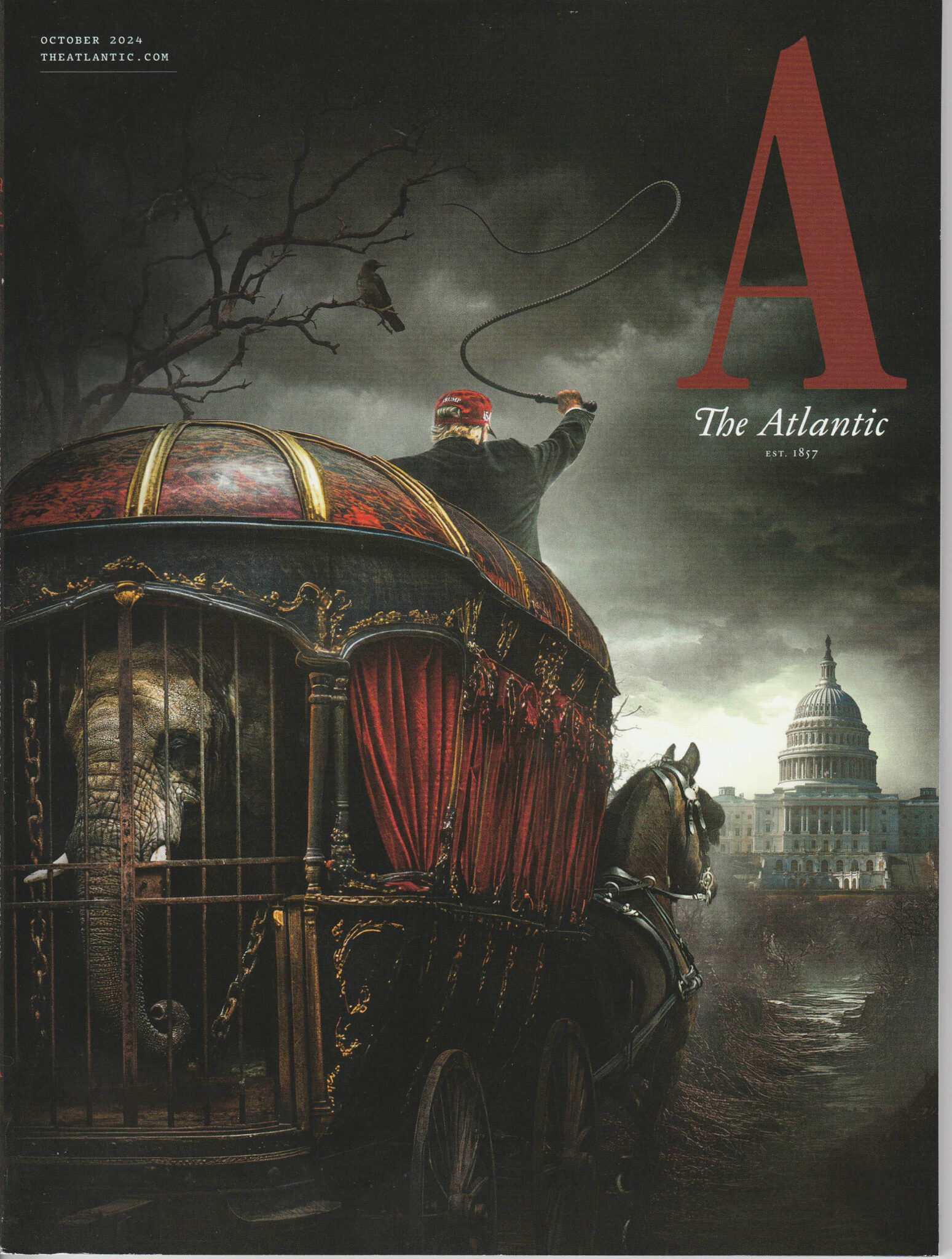
Our forefathers of the Constitution never thought the American people would vote for a criminal with such nefarious qualities and no soul. They never imagined that American voters could be so morally and ethically bankrupt and didn’t adopt any provisions in our Constitution to address such an unthinkable scenario. But here we are in 2025 almost 250 years later.
Maybe, the voters who put him there deserve what will happen to them in the next four years or what will not happen. They believed the con he was putting forth even though he proved beyond a doubt in the last eight years that he is a pathological liar, sexual predator, and a racist. And as philosopher George Santayana, who is credited with saying “Those who cannot remember the past are condemned to repeat it” is now true and happening today.
The featured photo above with elephant in the cage is from the October 2024 cover of The Atlantic magazine and depicts the current Republican party – soul-less, cowardly, and all fearing of the person driving the circus wagon soon to reach the White House. If one opened the cage and forced the elephant out, gave him a conscience and freedom to act on his own, he would turn and stomp, and struggle desperately to get back into the cage. They are truly Trump’s slaves programmed to obey his every whim.
The Trump cancer appeals to the MAGA Republicans and his allies because it addresses a basic, depraved instinct – selfishness. The Republican party is the party of selfishness because they believe they will get what they want supporting Trump – to stay in power, obtain more power, get richer, and do what they want with no accountability. To hell with the voters who put them in office or how much suffering it will instill on the American people and the damage it will do to America and the world.
It’s ironic that Monday is also Martin Luther King, Jr. Day, a federal holiday. Dr. King unselfishly lived and died for Civil rights in this country for all Americans. His dream may be shattered in the next four years.
It is a sad day for America.
___________________________
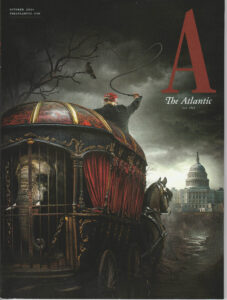 The October 2024 cover of The Atlantic magazine was created by Justin Merz based on the visual language of old Ray Bradbury and Stephen King paperbacks to portray a circus wagon on its nefarious approach to the Capital.
The October 2024 cover of The Atlantic magazine was created by Justin Merz based on the visual language of old Ray Bradbury and Stephen King paperbacks to portray a circus wagon on its nefarious approach to the Capital.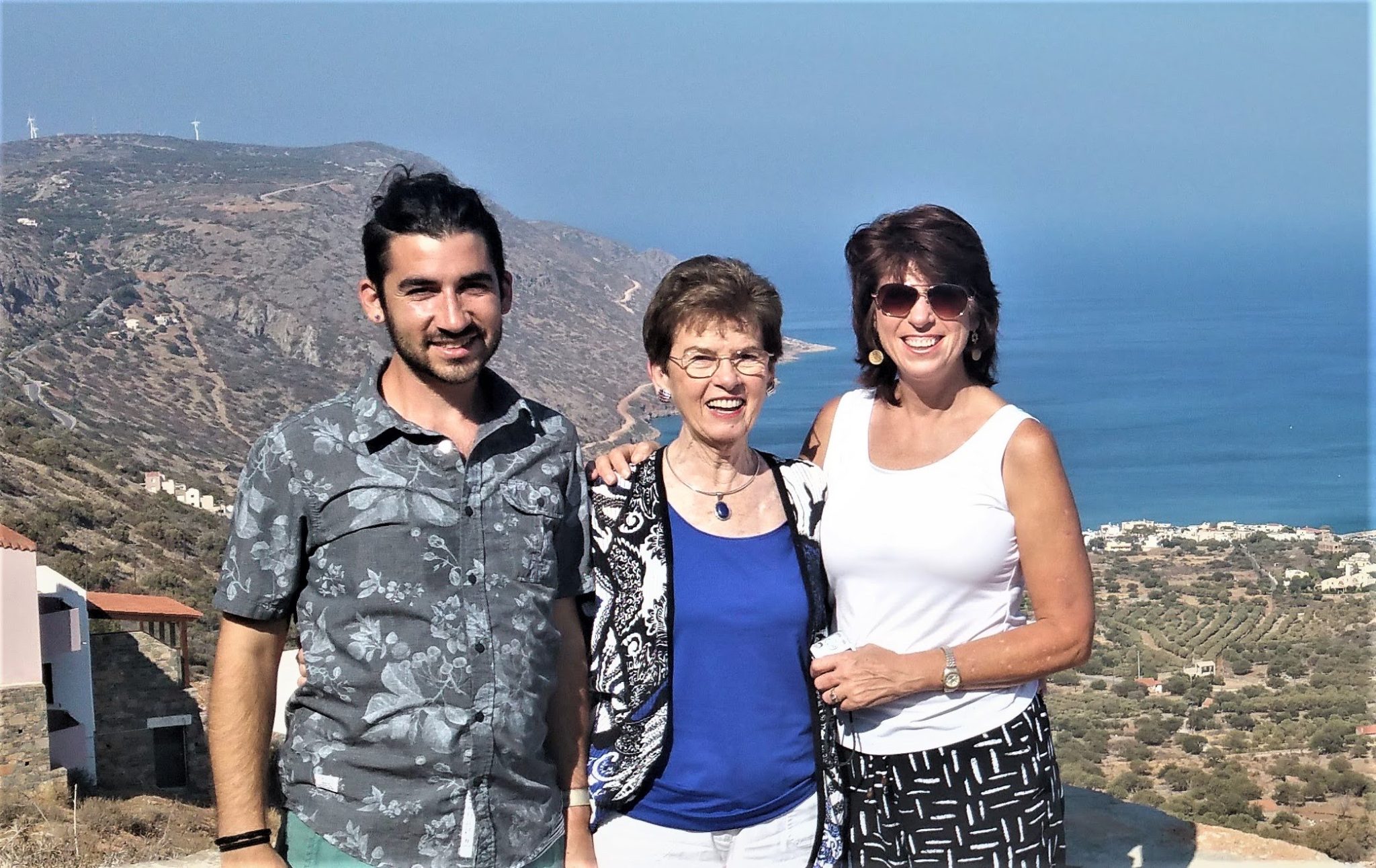
Register below
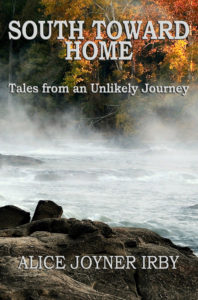
Publisher’s Note
When I first met Alice Joyner Irby, I knew she had an extraordinary story to tell about her life, her family, and the people who crossed her path.
As she finished each chapter over a little less than a year, I knew her extraordinary book was being created. And now it is here as South Toward Home.
Why Alice wrote this book.
“I want others to get to know the characters in my stories, for they are among the good-hearted, strong, independent people who helped make the 20th century the American century.”
Here is a brief synopsis of South Toward Home.
Catch the marvelous imagery in the reading of South Toward Home. Find yourself carried into bygone eras. You will actually encounter stories that span more than eight decades. Experience those remembrances if you have lived through some of these times!
Travel with author Alice Joyner Irby in her journey during periods of turbulent cultural and societal change. She reports her attempts to shatter glass ceilings confronting women in the workplace…her
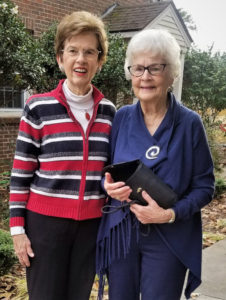
Alice and Glenn Dickens – 2019
role in integrating a university…her participation in the creation of the Job Corps in LBJ’s War on Poverty. Yet, Alice’s roots remain grounded in the South, where she was nurtured and raised in a loving community.
In her twenty-six stories, we come to know well this fun-loving young girl and those who shaped the woman she has become. A single mother with a daughter, the author expresses the bond between
the two. This is a relationship strengthened over time and deepened through their shared experiences. This book is a rare combination of intimate personal portraits coupled with a pragmatic look at the life surrounding them.
It is a book written for family about family, blood or not. Crises and joys…stress and well-being…harsh realities and great kindnesses…above all, Hope!
We, as readers, are drawn into the stories. We have known the folks encountered on these pages, maybe not personally; but these accounts cause us to reminisce about those who have poured into us the life-giving renewal that enables us to meet challenges, to celebrate life with all it brings, and to look up in faithfulness that endures. – Mary W., reader

By Carolyn Harmon
charmon@rrdailyherald.com
Reprinted with permission from the Daily Herald.
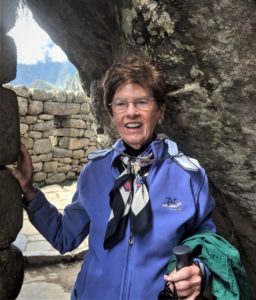
Alice Joyner Irby in The Sacred Valley, Peru 2018
Sit a spell and hear the church bells that called worshippers on Sunday morning — visit Greensboro when UNC-G was the Woman’s College — travel along on other adventures.
Alice Joyner Irby of Raleigh recently had her book published, “South Toward Home: Tales from an Unlikely Journey,” by the Outer Banks Publishing Group.
Alice was born in 1932 and lived in Weldon and after she moved away, she returned regularly until her mother died in 1991. She also visited her very good friend, the late Ruth Gregory Proctor of Halifax.
“Weldon has always been my home,” Alice said. “It is a book about my life, starting with Weldon and ending with Weldon.”
Alice grew up in Weldon, graduating from Weldon High School in 1950. She has lived through the Great Depression and the Korean War, in which her friends were drafted, she said.
“It was scary — and the polio epidemic — my brother, George Joyner, and I were quarantined for a summer, so reading about the pandemic now brings back some of those memories,” Alice said. “They didn’t know how you could get it, but they knew you could get it from other people. So we couldn’t have visitors.”
That is when she learned to play badminton. Alice’s parents were the late Margaret and William B. Joyner. William set up a badminton net during the polio quarantine.
“We couldn’t play ball, it would roll down the street,” she said. “We couldn’t go out in our yard.”
Alice’s sister is Margaret Joyner Kinker. Her brother, George, live in Morehead City and is married to a Roanoke Rapids girl, Gwen Dickens.
“We all came from Halifax County,” Alice said. “My parents were very active in the Methodist Church, and my mother’s family were some of the founders of that church in Weldon — the beautiful Gothic Weldon Methodist Church on Fifth and Washington — it is closed now.”
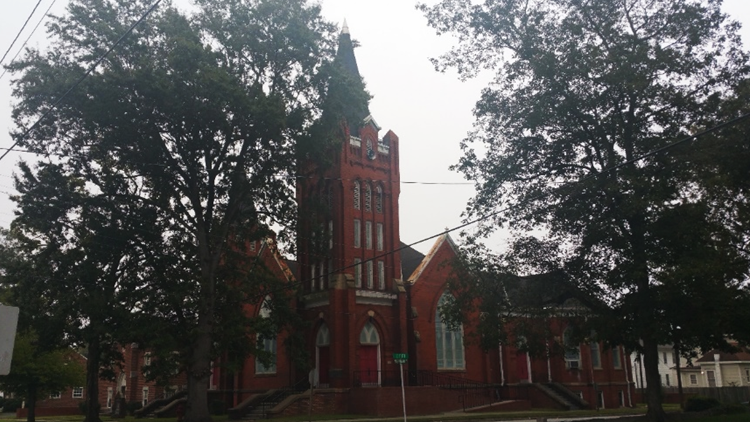
The Weldon Methodist Church, now closed
That is where Alice’s book begins — the first of 26 stories contains a picture of that church.
“The first section is about my growing up in the church, the importance of the church and the town. The second is about my brother, and our adventures — partners in crime — then I had a story about the four of us in Weldon.
“The four of us used to sing for funerals out in the country — sometimes in the family home and sometimes in a country church. They contacted the church, or they wanted some music, the four of us would pack ourselves in Ben Wyche’s car, he was always the driver and we would go sing.”
The four of them were Alice, Wyche, Blanche Selden Bullock, a classmate from Weldon High, who married Thurmond Bullock; and J.P. Ellis.
The first set of stories continues with Alice growing up, the train coming through, the second World War and what it was like living in Weldon during that time. The second set is what happened in Alice’s young adult life.
“One story has to do with how I was discriminated against trying to get on a United Airline Flight just for men in the early 1960s,” she said. “Some of the stories are about me hitting those barriers in those days. Another one has to do with my first job out of graduate school at Merrill Lynch in Greensboro, when I applied I was told, ‘You have the credentials that exceed, but we can’t hire you because you are a woman.’ The laws permitted that at the time.”
Another section is about her career while working for the Lyndon B. Johnson administration’s Job Corps, part of the war on poverty. She attended Rutgers University where she was the vice president for student services, followed by working for an educational testing service that makes the SAT and a lot of the admissions tests, she said.
In other sections, she writes about celebrities and her friends — her daughter, Andrea Irby, growing up with a horse; the time she met George W. Bush on a golf course in Pinehurst; her yard man; her sister, Margaret; two of her friends named Mary; her father; and the fortitude and courage of women in an earlier time, she said.
“I wanted to celebrate a lot of people who have been important in my life,” Alice said.
The book came out of a suggestion and encouragement of her editor in Raleigh, Linda Hobson, and a friend and fellow scribe, Ron Rhody, Alice said.
“We lived in Pinehurst — he said, ‘You really need to write your story for your family if nothing else.’ ”
An incident that happened in 2018, also encouraged her to write the book, she said, when her daughter’s husband, Cecil Bozarth, died suddenly of a heart attack at the peak of his career.
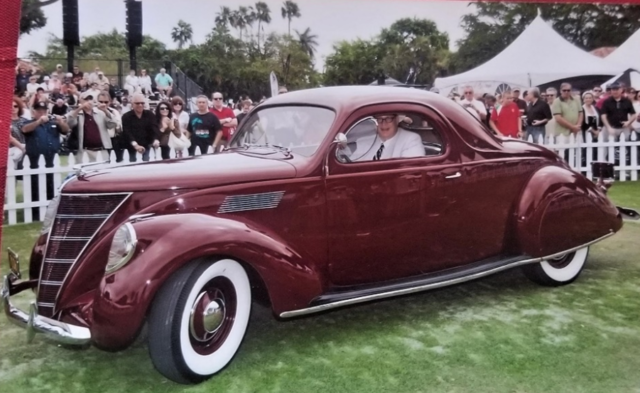
Cecil with his prize-winning Zephyr
“And that was a blow, it was really difficult to endure — I couldn’t write for awhile,” she said. “There were at least two stories that focused on my daughter and her family and I decided I should get those printed. I worked very hard for a year and got it published in April. I realized when I was doing it, when I really got going on it, I wanted to do it for another reason — to celebrate the people in my past — in Weldon and Halifax — that had meant so much to me.”
Another reason was to talk about the UMC Woman’s College in Greensboro, she said. The university had a sequence of names as it evolved. It was known first as the State Normal and Industrial School, and after 1897 as the State Normal and Industrial College until 1919. During the period 1919-1931, it was known as the North Carolina College for Women, and became the Woman’s College of the University of North Carolina from 1932 to 1963.
Alice said she graduated with an economics degree in 1954 and then earned her Masters in Economics from Duke University.
After “South Toward Home” was published, Alice had plans to share it in Halifax, but COVID-19 has changed her plans for now.
Her close friend and former classmate Glenn Dickens said the book will be sold in Halifax at the Bass House.
“And hopefully, if this pandemic gets over she can have a book signing here,” she said.
Dickens said Alice’s mother taught her French and was her favorite teacher. She said Alice is “a mighty fine person.”
“I am very impressed to have her as a friend,” she said. “I read the book and I thought it was wonderful and so well written I couldn’t put it down. I am reading it over because I am sure I missed a lot. It is so informative of things back in that time — it brought back a lot of memories.”
The book’s cover has its own story — it is a picture of the Roanoke River in Weldon, captured by Weldon resident and photographer, Lee D. Copeland.

Mist on the Roanoak River that became the cover of South Toward Home
Photo by Lee D. Copeland
Copeland Ltd Photography, Weldon, NC
Alice had a copy of the picture, without identification, and she wanted to find out the photographer’s name. She found it at the Riverside Mill in Weldon, where Copeland has several photographs for sale, he said.
After searching for a couple of days, she received some help from her daughter Andrea and Nancy Mueller, board member of the Halifax County Arts Council. Andrea found Copeland’s wife, Dee Riddle Copeland, on Facebook.
Dee’s mother, Janie, who also lives in Weldon, is 98 — they all live in Weldon, Alice said.
“She responded to my daughter on Facebook and Lee gave us permission to use it for the cover,” Alice said.
Copeland said the photo was in Weldon at the first falls on the Roanoke River near the boat ramp on the first cold fall morning several seasons ago.
“I had been watching the river for some time, waiting for three things to come together,” he said. “The falls colors to peak, the river to be low enough to flow through the rocks, the air to be cool enough to allow the mist to rise on the river from the warmer water.
“The three elements came together early on a weekend morning where I spent 90 minutes with my Nikon, photographing the area until the sun got high enough to dissolve the mist,” Copeland said. “I have always felt it was one of my best photos of the river and am very pleased that Mrs. Irby, after seeing the picture on a greeting card, was moved enough to track me down and ask permission to use it on her book cover.”
Copeland said, after the book was published, Alice and Andrea, while passing through the area, stopped by the Copeland’s front porch.
“And spent a delightful 45 minutes visiting with my mother-in-law, Janie Riddle, and Dee and I, reminiscing and discussing friends brought together by the Roanoke River,” he said.
Copeland said he has been taking pictures for 50 years, working professionally for about 20 and as a hobby the rest of the time.
“I worked at several newspapers in Eastern North Carolina, including The Daily Herald with Dick Kern as my editor. I covered the Nixon, Ford and Carter White House while in the Army, the bicentennial in Washington, D.C., and was appointed to the Jimmy Carter Presidential Inaugural Committee.”
As a result of the book, Alice has submitted it for two awards from the N.C. Literary and Historical Society Association and the North Carolina Society, she said. The suggestion came by way of a retired professor at NC State, James W. Clark. He is a well-known award-winning North Carolina writer, who went to Littleton High School, and who read Alice’s book, she said.
The two became acquainted.
“I am not sure when I will find out if I won, but I did send them in,” she said.
When asked why folks should read her book, Alice said it is what she calls a comfort book.
“They are stories about people who lived ordinary, but at the same time exceptional lives,” she said. “I think for many people it will connect to their own memories of their growing up. It is also a social history of about seven or eight decades.
“I am 87 years old, I lived through two-thirds of the 20th Century,” she said. “It will remind people of their own lives in those times. I have heard from people I knew when I was growing up and people who I don’t even know, and they identify with someone in the story. It triggers their memories of their own lives in those times.”
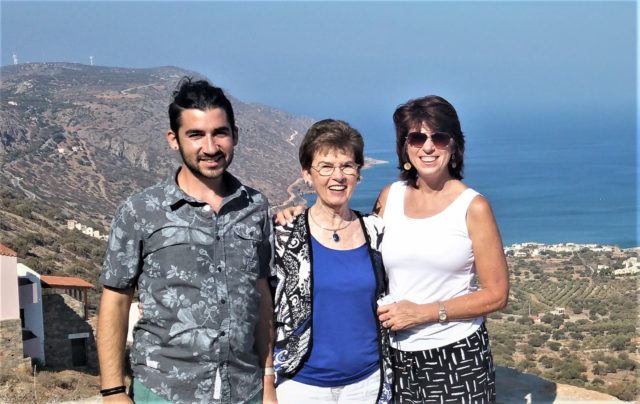
James, Andrea’s son, Alice, and Andrea on the Island of Crete, August 2016
The book is available at Amazon.com and the Outer Banks Publishing Group Bookstore.
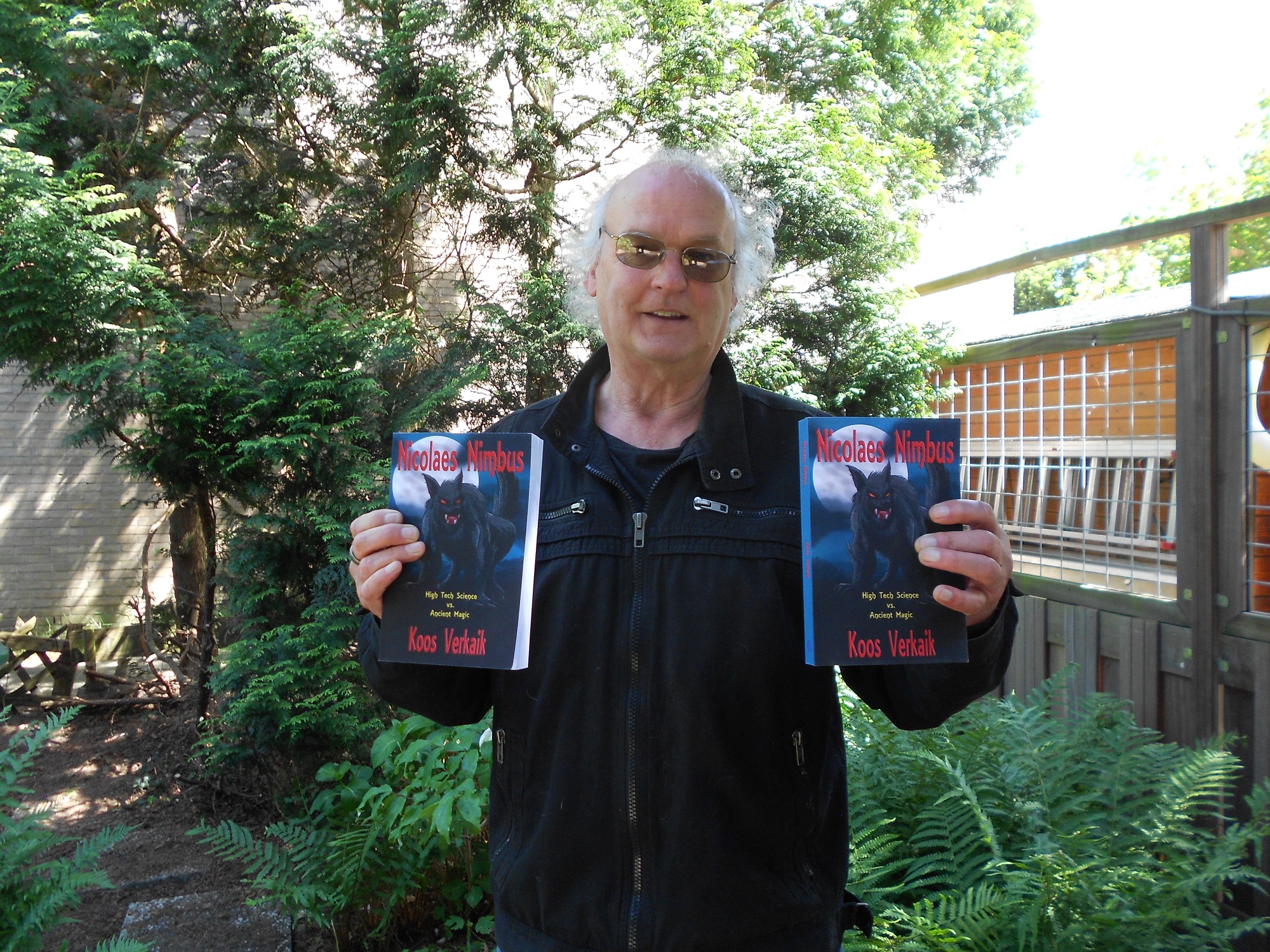
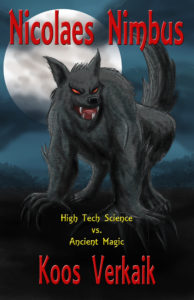 Publisher’s Note
Publisher’s NoteKoos Verkaik is one of the hardest working authors we know of today. He has 60 different titles under his own name and more than another 60 under a pseudonym! He a true master of the genre: Magic, Mystery, and Adventure!
For Outer Banks Publishing Group he has written the intriguing novels Heavenly Vision and The Nibelung Gold, plus the series of children’s books Saladin the Wonder Horse and Alex and The Wolpertinger.
Outer Banks Publishing Group has just published his newest novel, the sensational, breathtaking Nicolaes Nimbus, a high tech science vs ancient magic blockbuster…
From the back cover:
Scientists and wealthy owners of high-tech companies have pumped millions of dollars into the search for immortality. But does the future look bright or is there disaster waiting behind the horizon of time? The world is getting more complicated by the day, but who’s actually in charge?
A group of scientists in Germany have unmasked a cheating visionary. An intriguing phenomenon from the past turns up. Who is Nicolaes Nimbus? Is he an immortal man of flesh and blood from our ancient past? The hunt is on! The secret is priceless! Who is in control, the scientists or the mystic? The intriguing novel Nicolaes Nimbus embraces modern developments… and warns against ancient magic that never dies, waiting for the right time to manifest itself.
OBXPG: A book for this day and age, a book that had to be written…What is the book about?
Koos Verkaik: We live in a very interesting time, with a period of magic and superstition behind us and a period of unknown technical progress in front of us. You might say that we live in an interim. Allow me to tell you the facts in just a few words:
We see the world through the filter of our brain – brainstem, midbrain, frontal lobe.
As human beings, we are still evolving and we cannot imagine how we will see our world after our frontal lobe has grown, and it will. Scientifically, intervention will make us almost immortal, hyper-intelligent, and very different from what we are now.
Today we stand with one leg in the past (the magic and superstition I mentioned) and one leg in the future (longing for the possibilities that will make us live healthy and strong for ages).
Magic is still around us, but we are afraid of the future, of what will happen to the human race.
That is what Nicolaes Nimbus is about, ancient magic vs high tech science!
OBXPG: I assume you studied the past and the future for this novel?
Koos Verkaik: Oh yes! I always do a lot of research before I start working a novel. I am a collector of books about history, magic, strange phenomena, science, etc. There are over 2000 different books in my workroom and I know exactly where to find the facts I need for new novels. For Nicolaes Nimbus I read several non-fiction books. Here are just a few: Religion and the Decline of Magic by Keith Thomas, almost 800 pages of stunning information; The Secret History of the World by Jonathan Black, The Greatest Show on Earth, The Evidence for Evolution by Richard Dawkins; What We Cannot Know, Explorations on the Edge of Knowledge by Marcus de Sautoy and of course the great works of Yuval Noah Harari, From Animals into Gods, and Homo Deus. I admire the German author, Hoimar von Ditfurth, he has written in-depth about the universe, about the development of the human brain, and about the way life became possible on our planet.
OBXPG: Heavy stuff – but are your books easy to read?
Koos Verkaik: Yes. You can read my books as pure entertainment. On the other hand, you can read between the lines and discover interesting facts. My fiction is easy to read. I will take you by the hand and lead you through my odd worlds of fantasy. All my work is pure adventure.
OBXPG: Have you written about magic and science before?
Koos Verkaik: Many times. I wrote my first novel at the age of 18 and it was published right away. It was about a young man who offered his brain to build an intelligent starship. The main character, Adolar (also the title of the novel), said no to this weird proposal from the scientists, but his friend and colleague Jit agreed to do it. More than often I often perform tricks with the human brain in my books.
OBXPG: So you started very early as a writer. And it is said that you have never had writer’s block?
Koos Verkaik: I write like I work, from one to the next with almost no break in between. I was the youngest comic writer in Europe at the age of 16. Then I started to write novels. And I worked as a copywriter for a big agency always working, every day. I write in Dutch and then have my books translated into English with the help of my editors. Nicolaes Nimbus was edited by Dennis De Rose of Moneysaver Editing. He did a fantastic job with Nicolaes Nimbus and I intend to work with him on my next book.
OBXPG: Tell us some more about Nicolaes Nimbus.
Koos Verkaik: One of the main characters is Rein Vulpes, a young master painter from Rotterdam.
He always uses a stage name, derived from Vulpes vulpes, the Latin name for fox. His first name is his true name but he feels a strong affinity to Reinaert, the fox from medieval Europe portrayed in adventurous animal stories as a very sly rascal who is always one step ahead of the others. Rein always manages to nudge things his way, to manipulate people and situations. He knows how to lead everyone up the garden path, how to set a trap for other animals, from cats to dogs, from badgers to hare, even the strong wolf, the bear and the royal lion. He has memorized many lines from poems about the fox and every now and then when the situation calls for it, he recites:
“Then hear me, noble gentlemen, I will be happy to inform you how I, innocent like the hares, came to my first tricks and snares…”
Rein Vulpes is given to laughter, he is pliable but is not to be trifled with and he will get his own way. He lives from day-to-day confident that he owns the town; he diminishes all people around him to mere walkers-on in a play that is especially written for him.
“And when the curtain falls, when I breathe my last, it is all over and done – then nothing exists anymore.”
OBXPG: You come up with odd, colorful characters often. It has become a Koos Verkaik trademark. Can you expand on that?
Koos Verkaik: Nicolaes Nimbus is full of strange people, scientists, and charlatans, for instance. And then there is, of course, Nicolaes Nimbus himself, a most mysterious figure from the past, a sorcerer, a magician – but no one knows if he actually exists. Is he a just larger than life or is he still alive, perhaps immortal?
That is what it is all about in this novel – the search for immortality. A group of extremely clever rich German and Dutch scientists hopes to live forever. They search for different possibilities to prolong life and spend lots of money to reach their goal. Then they hear about a wizard who was supposed to have lived ages ago – Nicolas Nimbus. If Nicolaes Nimbus is still alive and has found the secret of immortality through magic; the scientists want to find him – to examine him in their labs! But they need master painter Rein Vulpes to set a trap for Nicolaes Nimbus. Then high tech science meets ancient magic…
Yes, this book had to be written… before magic has completely vanished from our world.
Here we stand, halfway up the ladder to perfection, with a brain that has not completely developed, the earthly past beneath us, and the heavenly future high above us…
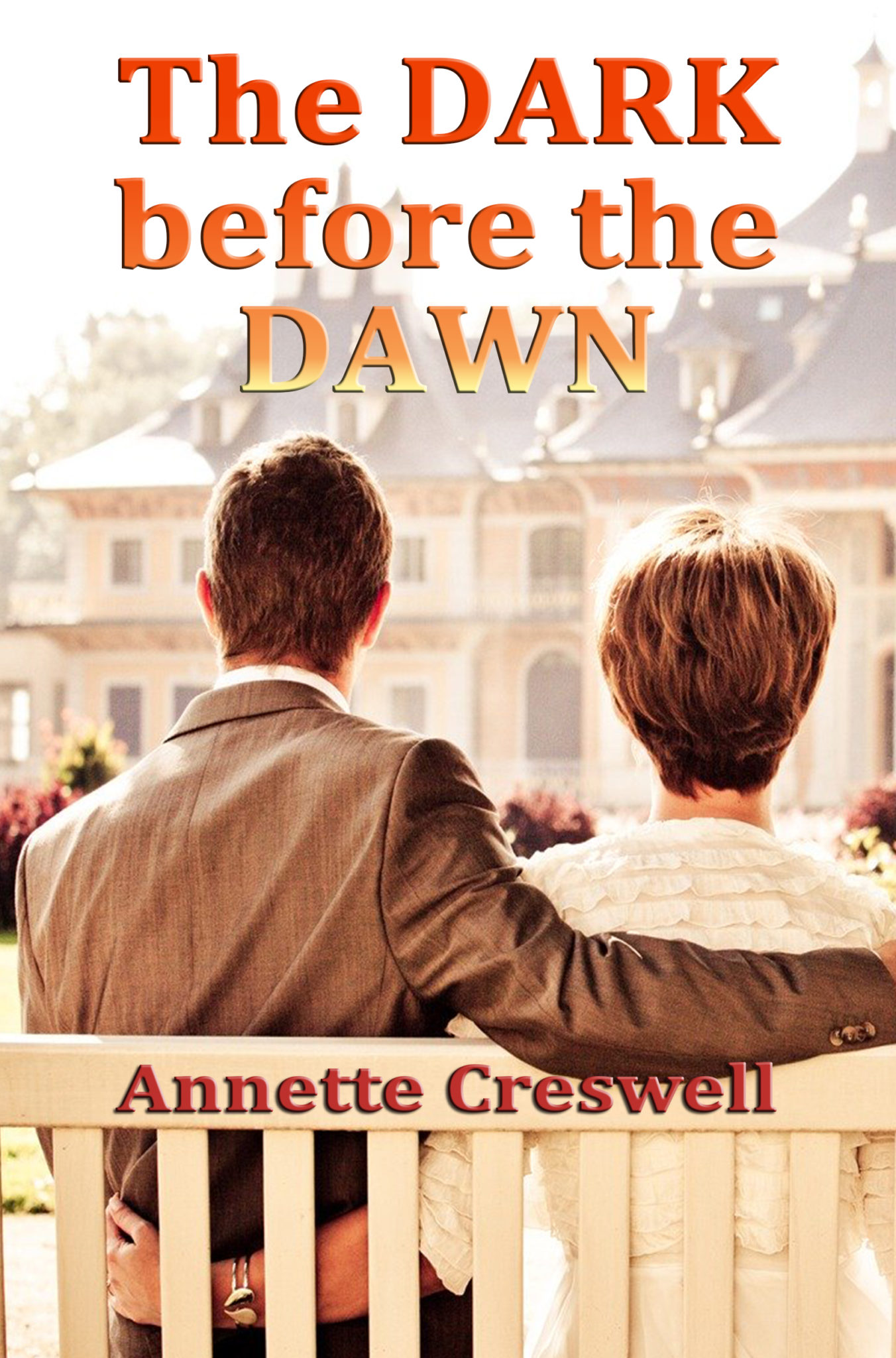
Listen to one of the chapters from Annette Creswell’s The Dark before the Dawn, a love story shortly before the start of World War II. The Dark before the Dawn is available here in our bookstore, on Amazon and in fine bookstores everywhere.
Synopsis
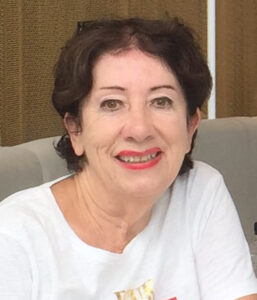
Author Annette Creswell
Just before the start of World War II, Peggy Davis, a London midwife, has a chance encounter with a stranger that changes her life forever.
When Peggy meets Charles, a wealthy lord as she boards a bus in front of Harrods department store, fate casts them together.
When Charles’ wife, Diana, and first child die in childbirth, Peggy, and Charles are thrust into a relationship of happiness, sorrow and unexpected tragedy.
They ultimately marry, have a son and adopt an east end refugee boy from London.
What transpires is a web of family dramas a la Downton Abbey with lesbian relationships, Nazi sympathizers and family secrets revealed as Peggy attempts to navigate through her new life from midwife to lady of the manor.
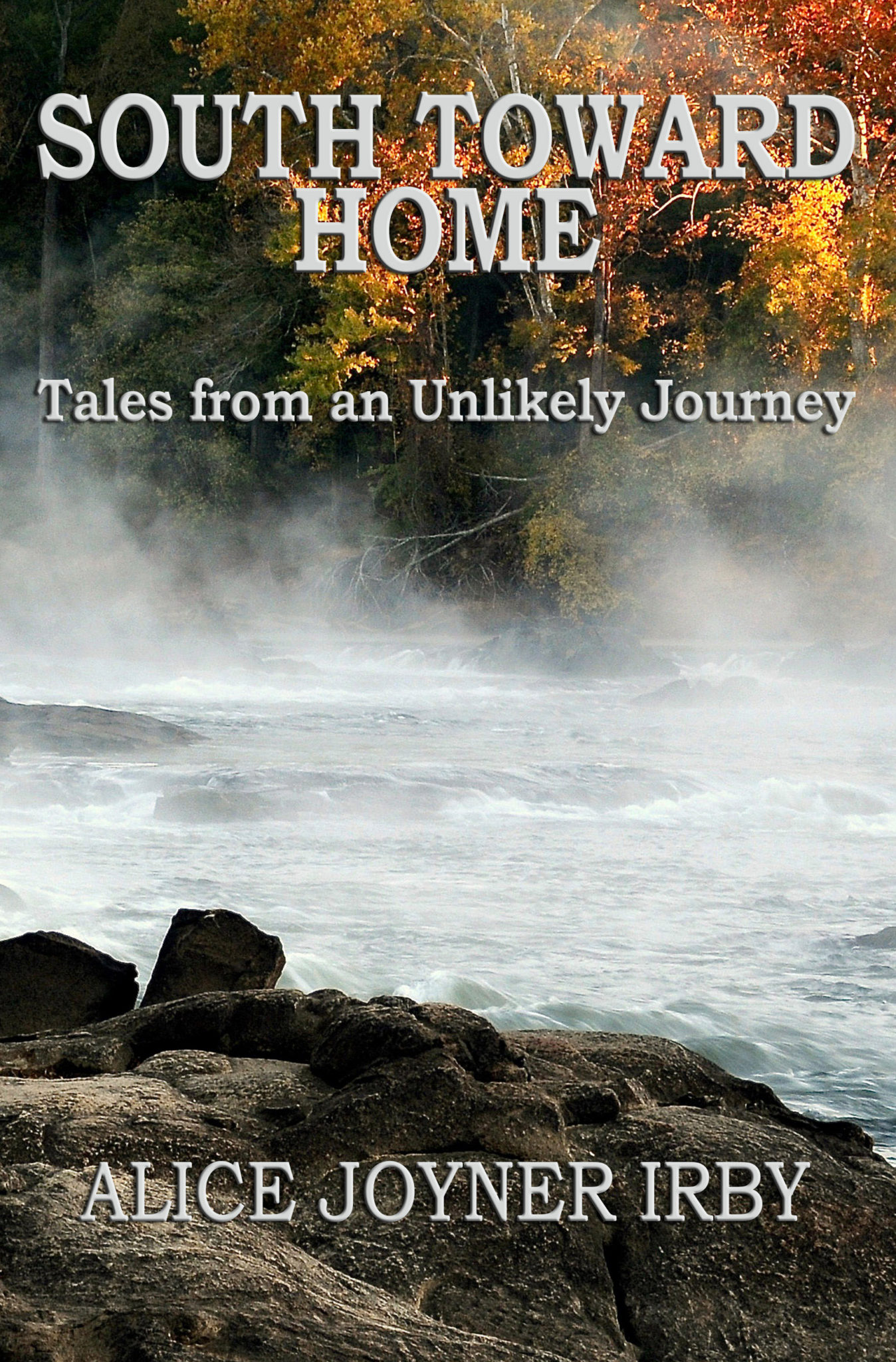
When I first met Alice Joyner Irby, I knew she had an extraordinary story to tell about her life, her family and people who crossed her path.
As she finished each chapter over a little less than year, I knew her extraordinary book was being created. And now it is here as South Toward Home, available on Amazon and in fine bookstores everywhere.
The Not-So-Friendly Skies is one of 26 stories in the book where Alice shows her grit in her struggle for women’s equal rights in a world dominated by men in the early 1960s.
By Alice Joyner Irby
MIXING IT UP
The Not-so-Friendly Skies
In the early 1960s B.C.—before cocaine, cohabitation, and the crises of riots and protests—it was business as usual for the airlines. At United Airlines (UA), that included Executive flights, code name for “men only.”
Two colleagues, Dick Watkins and Dick Burns—both heavy-set, tall men—and I were working together on a college grade-prediction study for Educational Testing Service (ETS), where I was then employed. The study included all four-year colleges in Indiana, 19 of them. Its purpose was to study the relationship among students’ high-school grades, SAT scores, and first-year grades in college.
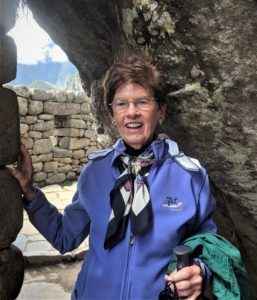
Alice Joyner Irby in The Sacred Valley, Peru – 2018
Our fieldwork included visiting each college, explaining the project to participating administrators, and collecting data on freshman classes for analysis back in Princeton at ETS. Over a period of three years, the three of us regularly flew together to Chicago and then to various cities in Indiana.
At least it started out that way. Then, one day, the two Dicks were booked on a flight different than the one on which I was ticketed. Pleased that she was able to offer an upgrade, the travel agent arranged for them to go on something called an Executive flight. I did not qualify and instead had to go on an earlier flight and wait for my colleagues in O’Hare Airport so that the three of us could take a puddle-jumper down to an Indiana city.
“This won’t do,” I thought—even though the Women’s Lib movement was only a gleam in Betty Friedan’s eye and did not get into full swing until the early 1970s. And, it wasn’t until the Civil Rights Act of 1964, Title VII, that federal legislation called for equal treatment in employment regardless of sex, race, color, religion, or national origin. Other legislation followed concerning housing, creditors and credit availability, and the well-known Title IX (1972). I was not an activist, but I expected to be treated fairly, and in this case, that meant being treated on a par with my peers.
For a while, I did nothing other than complain to myself and a few friends that every time I started out for Indiana, I got a little hot under the collar.
“Let’s see what we can do,” said Greg, a friend. At the time of our next scheduled trip, Greg and I decided to go to Newark airport to seek booking for me on the Executive flight scheduled to leave later that day. I already had a ticket on the earlier flight, knowing I would probably have to use it—but hoping an enlightened agent would rally to my cause.
“I am booked on Flight UA 323 to Chicago but want to change that to Flight UA 829 to be on the same plane as my colleagues.” I explained at the ticket counter. “My colleagues are Mr. Richard Watkins and Mr. Richard Burns,” I elaborated.
The United Airlines agent explained that the flight was not open to me.
“I know there are seats available, because I checked before I came,” I countered.
“It’s an Executive flight,” she stated.
 “What does the term ‘executive’ mean? Is it a title?” Greg asked. “Or a level of education? Or size of desk or office? Or having supervisory authority? If so, Mrs. Irby has the same credentials as her two male colleagues.”
“What does the term ‘executive’ mean? Is it a title?” Greg asked. “Or a level of education? Or size of desk or office? Or having supervisory authority? If so, Mrs. Irby has the same credentials as her two male colleagues.”
The ticket agent paused, somewhat taken aback, then was clearly unable to give us a definition of “Executive.” She fumbled her words, saying something like, “The men on these flights have to work while in the air, and it is very distracting for women with small children to be on the same flight. They need quiet. You have a seat on the plane that is waiting to take off now…,” the agent attempted to explain.
“You mean Flight 829 is for men only? Is that right?” I asked with an edge in my voice.
When we didn’t leave and continued to press the issue, the agent excused herself and disappeared behind the partition at the back of the counter. A second agent came out, another woman, who reiterated the first agent’s words: “The flight is for executive men who need a quiet atmosphere when working, and United Airlines wants to make the flight as conducive to work as possible.” She could not tell us how she determined which men were executives who needed to work while in flight.
“Is every male passenger an executive? It seems that any male qualifies as an executive and no female does. Is that correct?” I asked.
Greg asked to see the written policy. Then, she, too, disappeared behind the partition.
We were left standing at the counter while other customers were being helped by an agent several feet away from us. A few minutes passed and a third agent, this time a man, came out and told me the written policy was at United headquarters in Chicago and I would have to inquire there for a copy.
“And, Madam, if you don’t go ahead and board the plane for which you are ticketed, the flight will leave without you. We have already held the plane 45 minutes for you,” the agent spoke in a sharp voice. Not taking that flight meant that I would not be able to meet my col-leagues in Chicago later in the day.
“Well, I have to get to Chicago, but I do intend to inquire about the policy when I get there. After all, I will have two hours to wait until my colleagues meet me,” I spoke just as sharply.
Dutifully, I walked to the gate with Greg by my side. The tactic of protesting “victimhood” was not yet in vogue until the twenty-first century. This was a new situation for me; I was not combative nor given to protesting, and I didn’t know quite how to proceed. Greg and I discussed what I would say to the attendants, if anything, as I walked up the steps of the plane to board. We decided I would stay mum except to greet them cordially.
In the 1960s, passengers boarded planes by departing the waiting room at the gate, going outside, walking to the parked plane, and then mounting steps attached to the side door of the plane. I gave Greg a hug, leaving him in the waiting room, turned around, and walked to the plane. At the bottom of the stairs, I put on my best smile.
I was the only person with a smile. At the top of the stairs, the pilot, the co-pilot, and the stewardess stood in the doorway, staring at me with scowls. No one said, “Welcome aboard.” Instead, the attendant said, “Mrs. Irby, your seat is 8B and you need to seat yourself promptly because we are running quite late.” Her harsh tone was not lost on me.
No one helped me to my seat. Passengers stared at me as if I were an angry or an uppity, trouble-making woman. Apparently, word had spread that I was holding up the plane. I did get my free Coke—but mine came with a splash and a snippy word from the stewardess. I was grateful that my seat partner did not scorn me—outwardly, anyway. He was quiet.
United Airlines headquarters was on the second level of the Chicago O’Hare Airport. After I disembarked, I found my way to the United office. Again I faced another counter with a partition behind it, a place to hide! A male clerk was standing there, idle and seemingly approachable.
“I understand that United Airlines has an Executive flight, and I am interested in knowing the provisions of that policy,” I said pleasantly.
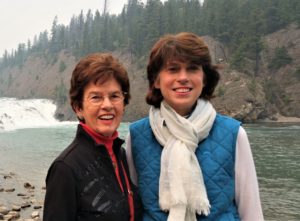
Alice and her daughter, Andrea in Canada – 2015
Clerks there had been notified. They were ready. “I’m sorry, Ma’am,” answered the agent on duty. “It is filed away in another building. We will be glad to send it to you.”
Even though they had my name and could look up my address, I wrote down my name and address and handed it to the clerk. Most likely, that little piece of paper found its way directly into the trash can. I was not naïve enough to expect to receive the policy, which, of course, never showed up in my mailbox.
“What was so special about the Executive flight?” I inquired of my colleagues when we met in the O’Hare terminal.
“Oh,” Dick Watkins said, “its purpose is just to pamper men. Passengers are given socks to use if they take their shoes off, and pillows, free drinks, and snacks to go along with their cigarettes.”
“Nothing special,” Dick Burns chimed in. “United thinks that paying attention to men gives them a competitive advantage. And, as you know, most business travelers are men.”
Dick W and Dick B were not impressed with the perks and agreed with me that Executive flights did not make sense, especially since they were clearly discriminatory. Both of my colleagues were tall, large men and would have preferred more seat and leg room rather than the pampering.
What went unsaid was that the flight attendants, by United policy, were single women, very attractive and practiced in providing good service. I’m sure they were not flirts. Neither were the men, but doesn’t anyone like to be pampered?
Discrimination thrived inside the airline companies as well as in policies affecting their passengers: no men or married women were hired by the major airlines in that decade to serve as flight attendants. If a woman married, she had to resign her position.
I put the matter out of my mind and continued my work on the project with the two Dicks. Later that year, as I prepared to go to Washington to join the Johnson Administration for a year, the situation popped back into my awareness. I felt a twinge of resentment. Executive flights were not only discriminatory on their face but affected business arrangements and relationships as well. I deserved to be treated fairly, on a par with my colleagues. How could airlines get away with such policies? I was convinced they shouldn’t.
Maybe I was just sensitive to the winds of change as I prepared to go to Washington, on leave from ETS, to assist in establishing the Job Corps as part of President Johnson’s War on Poverty. Once there, I began working with a young lawyer, Stan Zimmerman, who was also on the Job Corps Director’s staff.
One afternoon, as we were idly chatting, I told him about my experience with United’s Executive flight.
“Let’s have some fun,” he said, upon hearing my story. We determined that the Executive flights were still in use. Using his law firm’s letterhead, Stan wrote to United Airlines, representing me as his client and raising the question of the legality of their practice. He insisted the airline cease such discriminatory flights, pointing to the proposed civil-rights legislation that President Johnson initiated and was beginning to move through Congress. Quite likely, United’s practice was not yet illegal, but that did not stop Stan and me from rattling our sabers.
United Airlines acknowledged receipt of the letter but that was all: no admission of anything. That’s what we expected. Life went on and, in fact, became all-encompassing at Job Corps headquarters as we worked feverishly to develop the infrastructure of the program.
To our surprise and pleasure, a couple of months later we determined that, quietly, the UA “Executive flight” had taken a nose dive into the dust: no widely distributed press announcement, not even a newspaper article. Nary a murmur from a traveling businessman that elimination of the Executive flight reduced his productivity—remember, they were supposed to be segregated from women so they could work!
The flight merely disappeared from the list of arrivals and departures at airports and was no longer listed in the airline guide used by travel agents.
After work that day, Stan and I raised our glasses with a toast: “A Hand Up for Women’s Rights, and a new nail in the coffin of Inequality!”
About the same time, another woman from Weldon High School stuck her neck out. Jean Satterthwaite moved to New York City after graduation from the Woman’s College, married a school counselor/writer and, when looking for work, realized that The New York Times’ classified employment ads were divided according to MEN and WOMEN. In other words, not only was employment policy discriminatory in many places, job descriptions and classifications were as well.
Occasionally, the policy disadvantaged men, as in the case of UA’s policy on flight attendants needing to be women, but, by far, its sword fell most punitively on opportunities and prospects for women. Jean and a few other women organized a protest of The Times’ classification system by gender, which had been copied, quite naturally, by every other major paper in the country. They wrote letters, made telephone calls, and brought the policy to the attention of civic clubs and business associations, urging them to write and call as well.
The women were successful. After some foot-dragging and flimsy excuses, The Times backed down, realizing it lacked a defensible business reason to continue the practice. Things changed—want ads were listed by job classification, not gender.
Eventually, other major newspapers followed its lead. Jean went on to be the first president of the NYC chapter of the National Organization for Women (NOW).
Greg, who came to know both Jean and me, vowed there was something in the water we drank in Weldon or the food we ate in the dining halls of the Woman’s College. Where had the seeds of that independent, assertive, spunky spirit been planted?
Who knows?
Maybe the seeds were borne by the fast-flowing, powerful waters of the Roanoke River. Or by the toil of strong-willed, independent farmers and merchants, laboring without a government safety net to help them in hard times.
Maybe they were passed along in the discipline that Mr. Thomas, our school superintendent, enforced with his reliable sense of fair play.
Or maybe by the demeanor and actions of our role models, the women faculty at the Woman’s College, or the history and philosophy professors there who awakened dormant portions of our minds to show us new horizons. Or maybe the seeds germinated first in the rich black dirt of Eastern North Carolina that stuck to our feet and made us independent, adventurous Tar Heels.
September 2017
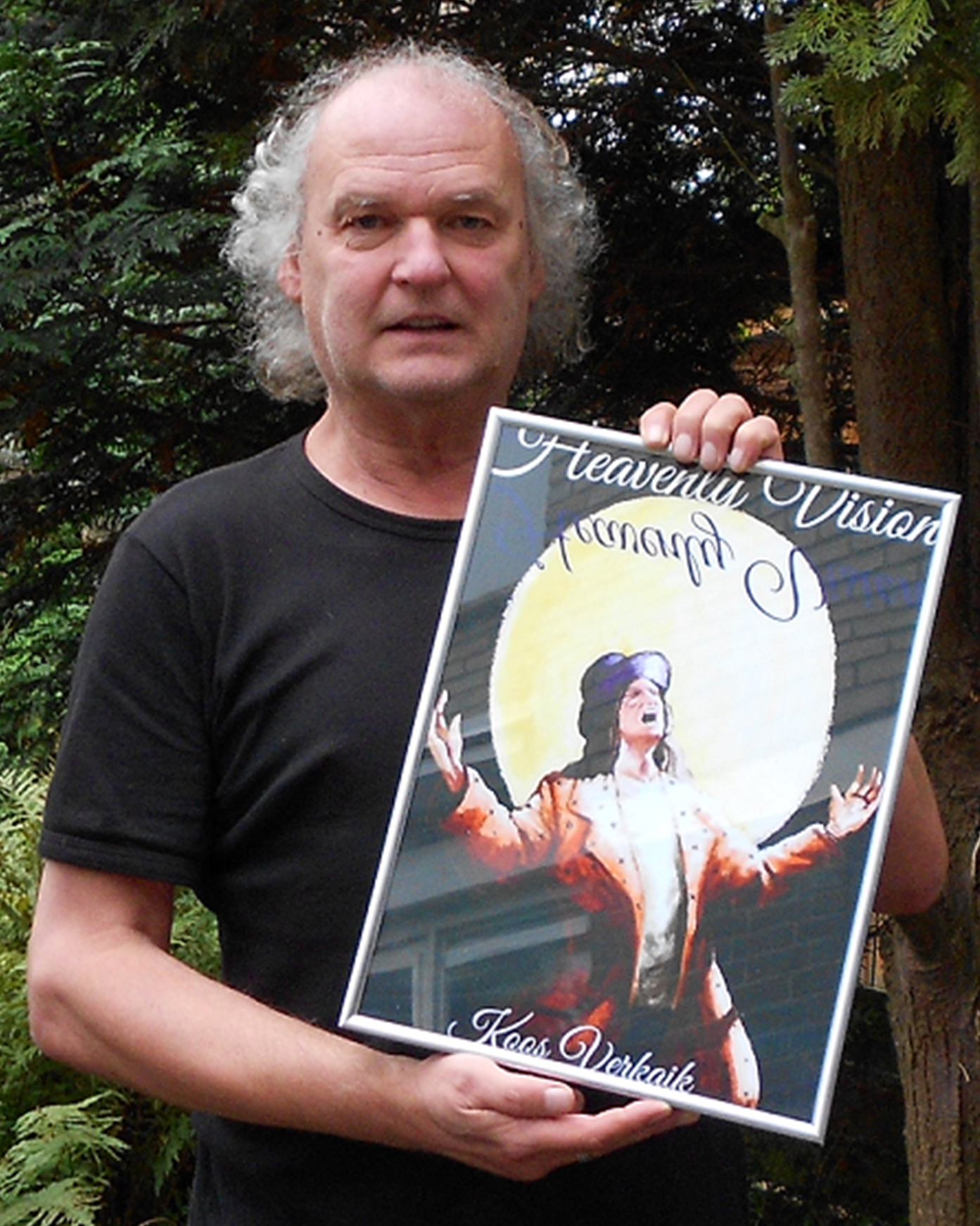
Dennis DeRose’s review on Goodreads of Koos Verkaik’s Heavenly Vision will convince you this is a book you must read.
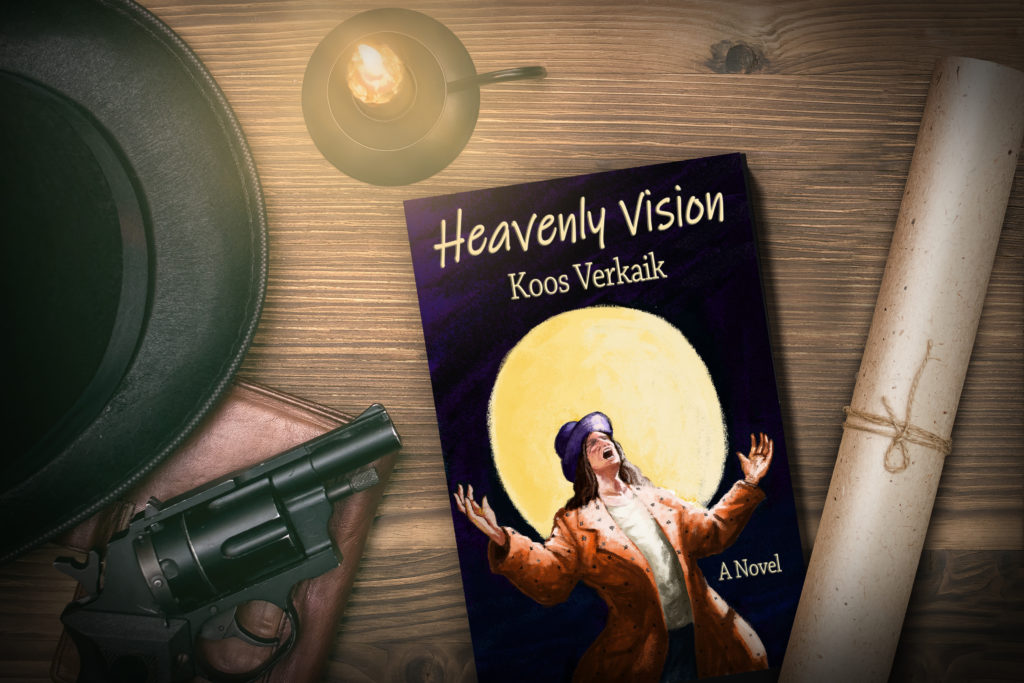
The cover was drawn by Doriano Strologo, an illustrator in Numana, Italy, depicting the main character in the book, the mysterious Raso, the man who had the heavenly vision.
by Dennis DeRose
HEAVENLY VISION is like an out-of-focus jigsaw puzzle but the longer you stare at it, the sharper the image becomes until everything is crystal-clear at the end. Koos knows how to play to the reader as he gently but firmly makes you turn the pages as the action continues from the first page to the last. As you read the last few pages you may shout… NOW I GET IT!

Enjoy the official music video for Trans-Siberian Orchestra – “Christmas Canon” from the album ‘The Christmas Attic’ (1998). “Christmas Canon” is set to the tune of Pachelbel’s “Canon in D”.
The True Meaning of Christmas reprinted from Wikipedia
The true meaning of Christmas is a phrase that began to appear in the mid-19th century when a shift toward a more secular culture resulted in a national backlash. Christians began to see the secularization of the celebration day of the birth of Christ as the shift toward Santa and gift exchanging replaced the celebration of the advent of Christ and giving to the poor and needy without expectation of receiving anything in return.
The poem, “[[A Visit from St. Nicho (1822) helped popularize the tradition of exchanging gifts, and seasonal Christmas shopping began to assume economic importance. Harriet Beecher Stowe criticizes the commercialization in her story “Christmas; or, the Good Fairy”.[1] An early expression of this sentiment using the phrase of “the true meaning” is found in The American magazine, vol. 28 (1889):
The phrase is especially associated with Charles Dickens‘ A Christmas Carol (1843), in which an old miser is taught the true meaning of Christmas by three ghostly visitors who review his past and foretell his future.
The topic was taken up by satirists such as Stan Freberg and Tom Lehrer during the 1950s and eventually by the influential TV special A Charlie Brown Christmas, first aired in 1965 and repeated every year since. “That’s what Christmas is all about Charlie Brown”, says Linus, referring to the birth of Christ. Dr. Seuss’ How the Grinch Stole Christmas! (1957) also illustrates the topos, and was very influential in the form of an animated TV special produced in 1966. The phrase and the associated moral became used as a trope in numerous Christmas films since the 1960s.
The phrase found its way into the 2003 Urbi et Orbi address of Pope John Paul II, “The crib and the tree: precious symbols, which hand down in time the true meaning of Christmas!”[2]
So enjoy the festive season and get ready for Santa to squeeze down your chimney.
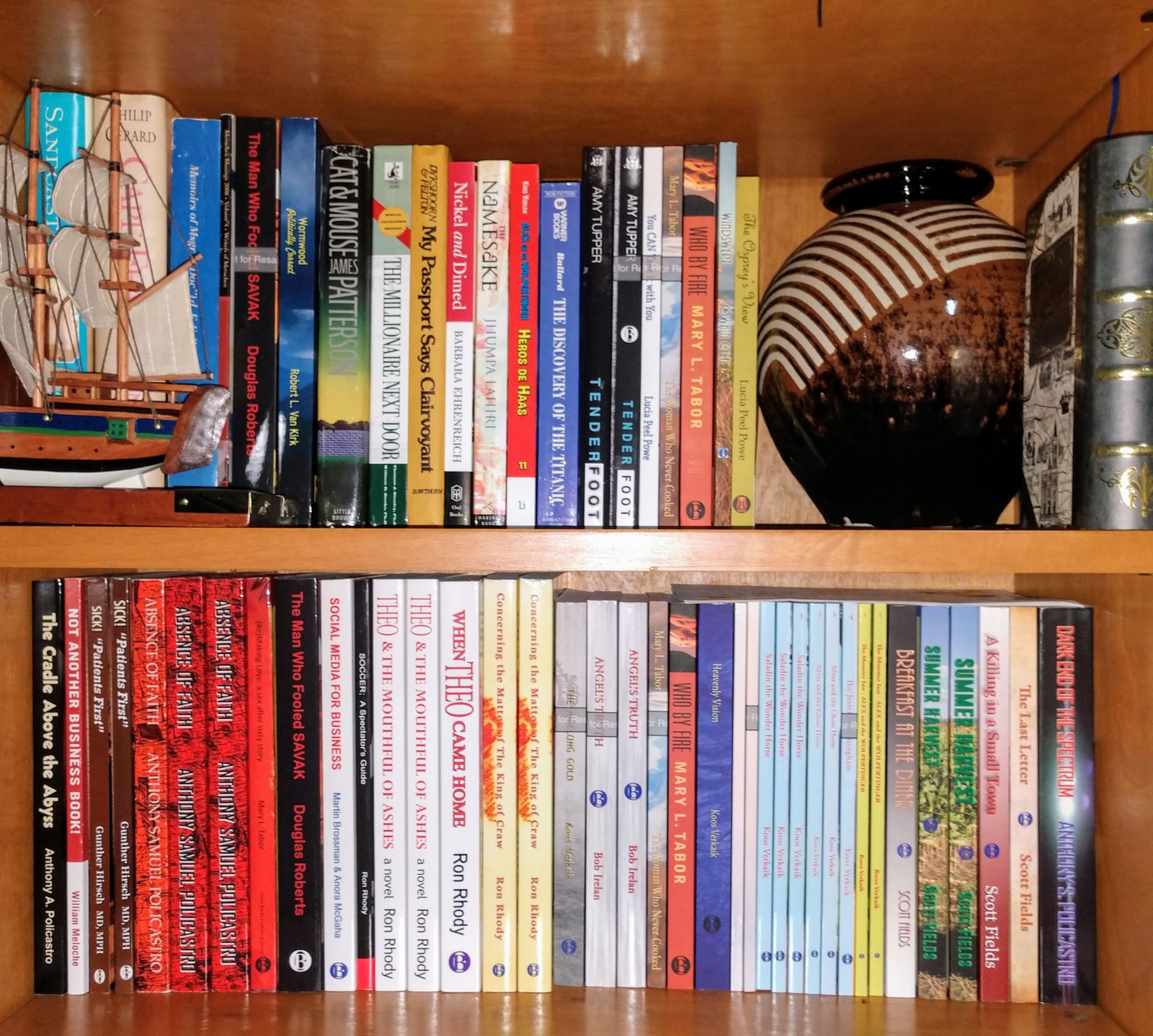
Welcome to our book store
We hope you find a book that will enlighten your life

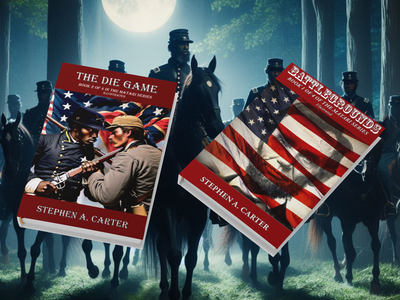
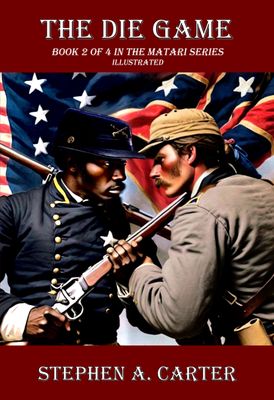
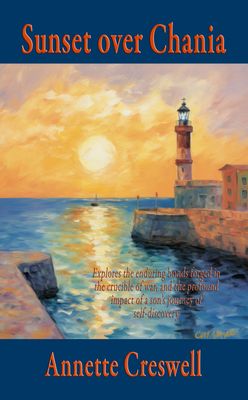


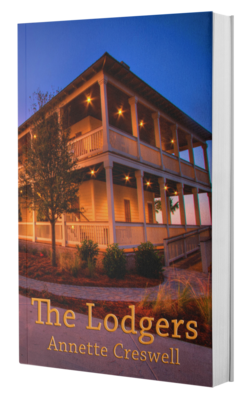
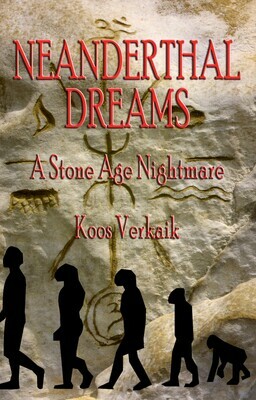
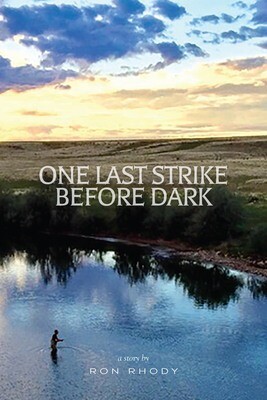

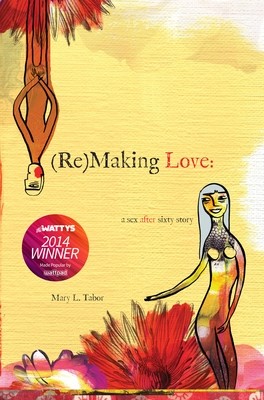
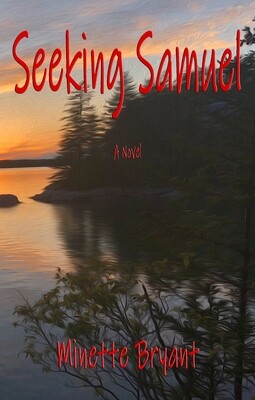
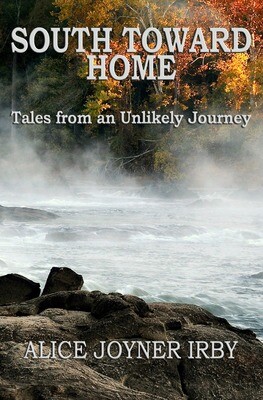

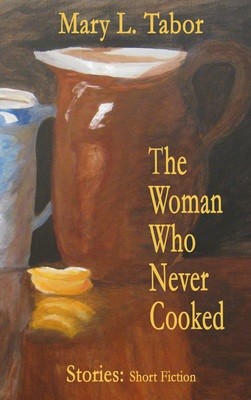
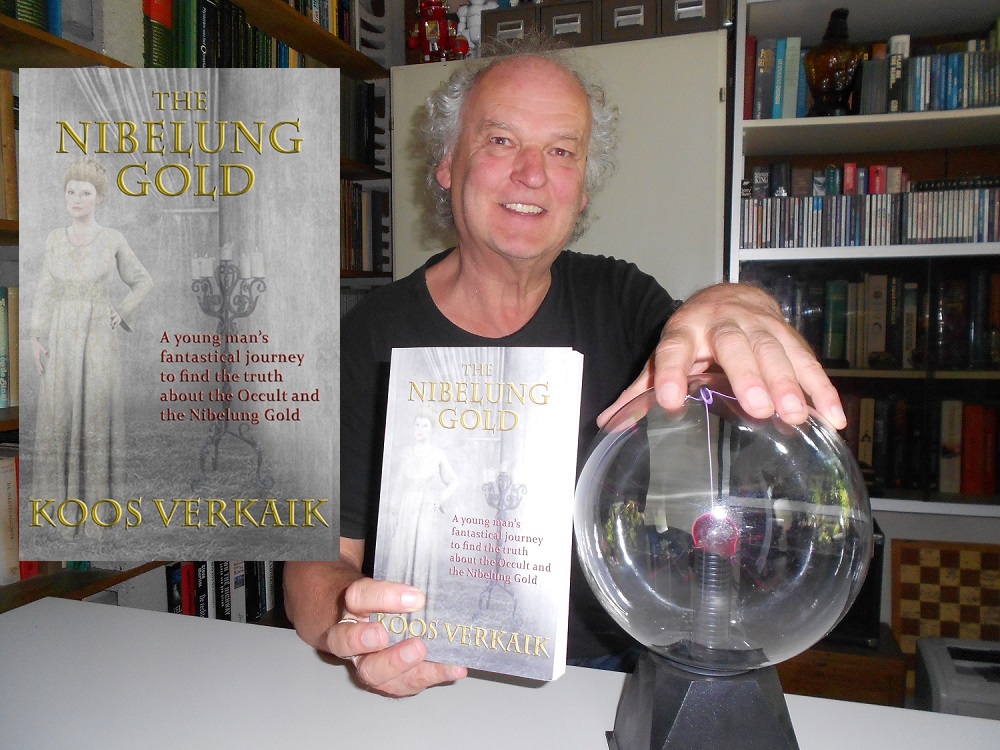
Outer Banks Publishing Group author Koos Verkaik’s newest book, Nibelung Gold, takes the reader into the world of the paranormal with a twist. He was recently interviewed about Nibelung Gold by Lauretta L. Kehoe, an avid reader, blogger and book reviewer. Here is are some quotes from her interview with Koos Verkaik.
“I am interested in everything that has to do with magic. Have a nice collection of books about all the mysteries in the world, about human history, about alchemists, about… everything! More than often I need no more than one single idea to create a book. For The Nibelung Gold I was thinking: what, if a group of magical fortune tellers concentrate together on one person, what will happen to him? I combined that with the old European saga of the Nibelung Gold and started writing. I am very happy with the result. This is a book for people who like to know more about occult events from the past.”
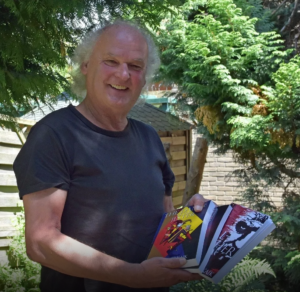
Koos has written over 60 books and furiously continues to write new novels full time in his home outside of Rotterdam in The Netherlands.
“Novels, series of children’s books, hundreds of scripts for comic artists, wrote songs and made albums and was a copywriter. To make a living, I wrote 4 books every month for a big distributor. Always had inspiration, never had a writer’s block. Sit down, start writing… The same way a painter can be obsessed and never puts his brush away.”
As Koos has said, “Writing is as necessary as breathing to me!”
Read the rest of the interview here>